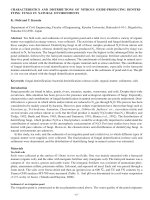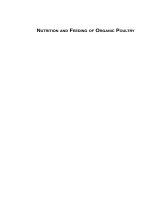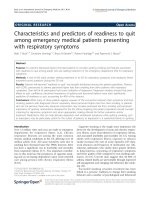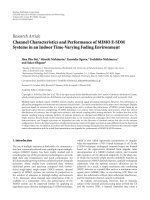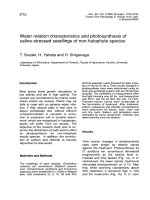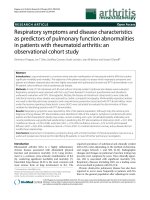Nutritional characteristics and feeding of rabbitfish (siganus guttatus) in tam giang cau hai lagoon systems
Bạn đang xem bản rút gọn của tài liệu. Xem và tải ngay bản đầy đủ của tài liệu tại đây (149.02 KB, 9 trang )
Journal of Agricultural Science and Technology A and B
& Hue University Journal of Science 5 (2015) 561-569
doi: 10.17265/2161-6256/2015.12.015
D
DAVID
PUBLISHING
Nutritional Characteristics and Feeding of Rabbitfish
(Siganus guttatus) in Tam Giang-Cau Hai Lagoon
Systems
Nguyen Quang Linh1, Tran Nguyen Ngoc2, Kieu Thi Huyen2, Ngo Thi Huong Giang2 and Nguyen Van Hue2
1. Center for Incubation and Technology Transfer, Hue University, 07 Ha Noi Street, Hue City 47000, Vietnam
2. College of Agriculture and Forestry, Hue University, 102 Phung Hung Street, Hue City 47000, Vietnam
Abstract: The research aimed to investigate for lagoon foodweb and dietary composition for rabbitfish in different stages (larvae,
fingerlings and grower). Data were collected from two experiments using basic methods in field and laboratory. Experiments were
structured on 2,000 larval head, 500 each tanks for nursery and 90 heads of three groups were collected in different seasons to
laboratories for analysis of feeding intake and food compositions. Results showed that the number of omnivorous species, including
animals, plants and organics, have been identified and grouped in 39 genera, 30 families, 23 sets, eight classes and six branches.
Animal groups have been identified as 18 breeds, 18 families, 13 lines, three classes and three animal species of industry animal.
Plant foodweb, mainly Bacillariophyta, have accounted for 27 genera and 67.5% of total expenditure vegetation eaten by the
rabbitfish. For the animal feed industry joint foot, Arthropoda have the highest number of 15 varieties, accounting for 83.3% of the
animal’s nutritional ratio. Organic residues as food for species have the highest prevalence in digestive tract (94.4%). The dominant
food groups were determined as 15 genera and five animal breeds, particularly those large groups of algae.
Key words: Rabbitfish, nutrition, foodweb, characteristics, lagoon.
1. Introduction
Tam Giang-Cau Hai lagoon systems, a largest
lagoon in Asian region, has more than 200,000 ha
water covering areas, and there is a biodiversity of
aquatic species and one of economic and potential
food species, as rabbitfish (Siganus guttatus). There
were studies and researches have done on this species
to produce larvae, but not successful for the stage of
nursery periods, and larvae are all dead after 7 d [1-3].
So, farmers often collect the fingerlings from sea into
lagoon through two inlets—Thuan An and Tu Hien,
and numbers of the fingerlings are reducing in lagoon
gradually [2-4]. For the problems for larvae death
after 7 d of hatching by no food and starvation,
Puvaneswari et al. [5] conducted a study to test
Corresponding author: Nguyen Quang Linh, professor,
research fields: nutritional diseases and systems for livestock
and aquaculture.
problem of no food in digestion systems and thus dead.
The questions were reminded which kinds and types
of feedstuffs and foodweb that can be adapted for
them in early growing stages. The hypothesis of the
study can be pointed out and conducted to practice for
microalgae or zooplankton supplied. In the discussion
of hatchery the larval nauplii diets of Brachionus,
Artemia and artificial food are also concentrated [6].
At larval stage, the fish grow very quickly within 24 h,
the mouth of this species opens at 36 h after hatching,
and learns to eat at 60 h after hatching [7, 8]. The
larvae of S. guttatus starts to consume the yolk
common and nutritious on day 2, and mortality
happens very high in the 3rd and 4th day due to the
lack of appropriate foods [9]. The diets required for
larvae are less than 90 μm as size of Brachionus,
10-20 individuals/mL can be combined with other
ingredients. The algae Chlorella, Isochrysisla and
562
Nutritional Characteristics and Feeding of Rabbitfish (Siganus guttatus)
in Tam Giang-Cau Hai Lagoon Systems
Tetraselmis are larval food source, but not used at the
4th day of S. guttatus larvae when exposes photophilic
and flow properties as they reach full body length
2.6-2.7 mm, but photophobic properties disappear
afterward at 9.2 mm size. Larvae size in the tank
bottom runs stable in 19.6 mm size [9]. The eggs of S.
guttatus hatched from the wild were often subjected to
changes in salinity 24‰ and the lowest at 8‰. Tests
for salinity tolerance on the different ages of Discus
showed 0-day-old larvae resistant to low and high
salinity concentration at 8‰ and 37‰, respectively,
for a better larval age at day 14. From 21 to 35 old
days, larvae can withstand sudden changes in salinity
at 35‰ [4]. According to Ref. [9], there was not any
significant difference observed in the survival rate of
larvae reared at 20‰-32‰ salinity. The survival rate
of larvae was enhanced at the temperature of around
22-26 °C.
There are more difficulties that the authors study
the nutritional features and characteristics as a basis
for producing artificial breeding discussion. The
inherent natural food in the brackish lagoon with
different salinity change creates diverse plankton and
microalgae. The goals of study are to find suitable
nutritional characteristics and feeding regime for
different growth stages of rabbitfish, and identify the
possibilities of using different types of food and
foodweb. The alga Chlorella, Isochrysis and
Tetraselmis are good sources of feedstuffs and
foodweb to use for larvae on the starting four days
period of feeding [4, 9]. The authors prefer to use
zooplankton feed synthesis or Isochrysis or in
combination with Chlorella and Brachionus.
Crustacean nauplii larvae of copepod is suitable for
the first stage of nutrition than Brachionus, but their
biomass remains a problem which should be studied
furthermore in the study and experiment practices.
2. Materials and Methods
2.1 Fish Samples
The fingerlings were collected from wildlife, started
nursery at enclosed nets for 7 d for adapting period
and designed into two experiments. Besides, these fish
samples also were collected from wild condition for
determination of the nutritional characteristics. All
fish were cultured at Loc Binh and Hai Duong
communes, Tam Giang-Cau Hai lagoon systems.
2.2 Experimental Design
2.2.1 Experiment 1
Collecting a total of 2,000 wildlife rabbitfish larvae
with 1-2 cm length and allocated into the 16
composite tanks, then divided into four groups of 500
individuals per tank and observed the ability to catch
food under the different food groups. Larvae were
reared in composite tanks and maintained in the water
temperature from 23 °C to 30 °C. Then they were
allocated into four groups and larvae were fed
Polychaeta for group 1, Artemia for group 2, Rotifers
(Brachionus plicatilis and Brachionus rotundiformis)
for group 3, and Chlorella, Tetraselmis and Isochrysis
for group 4, respectively.
2.2.2 Experiment 2
Different sizes of rabbitfish are collected in the wild
and then undergo surgery to remove the food from the
gut to analysis of nutritional composition. There are
three groups of fish were analyzed with feed
ingredients in the gastrointestinal tract. The three
groups were allocated as: group 1 with size of 4-12 cm
(30 heads), group 2 with size of 12-20 cm (30 heads)
and group 3 with size > 20 cm (30 heads), and they all
were fed by commercial feedstuffs.
2.3 Methods
Fishes in every tank were fed after 1 h, and 24
individuals were randomly collected to test the ability
to catch prey and not catch the food, then 3 h to
continue catching 24 samples were randomly collected
again for test in each nusery tank. Data were
calculated according to the proportion of saturation
and description of the ability that fish can catch baits.
The first of full “0” means without food in the
Nutritional Characteristics and Feeding of Rabbitfish (Siganus guttatus)
in Tam Giang-Cau Hai Lagoon Systems
gastrointestinal tract, the second level of full “1”
means food appeared in the food pipe, the third level
of full “2” means in the gastrointestinal tract have
some food, but still many blanks gas, the fourth level
of full “3” means in tube full of food digestion
medium (no space to accommodate gas), but not tense,
and the last level of full “4” means in tube filled with
food digestion and swollen than normal.
Samples were surgical and laboratory analysis was
done at the Center and Institute of Biotechnology, Hue
University.
The
nutritional
characteristics
and
functional characteristics of gastrointestinal tract were
tested, and the ratio of the intestinal length compared
to body length was observed. Gut and body lengths of
the fish are observed and meanwhile the shape and
structure are described to determine the length.
Through that, we can be aware of its feeding habitat in
the wild. Based on the research results in fish bone on
the relationship between gut length (Li) with length (L)
to known the spectrum as well as the food eaten of the
whole disk [3]. Fresh fish samples were collected and
put into a plastic box containing 10% formalin for
conservation up to labs, and sampling was in May and
September. The composition and species of flora and
fauna, which they ate and were contained in the
digestive tract, were determined by comparing
morphological method. Group of plant material used
by the authors in report of Ref. [10]; and zooplankton,
the group of animals and bottom materials were used
as reported in Refs. [11, 12].
2.4 Analysis and Determination
Identify the frequency of one type of food and
record the number of times encountered such feed in
the first paragraph and the gastrointestinal tract
associated with the observed morphological anatomy
of the digestive tube of Discus [13, 14]. Determination
of full eating is based on the amount of food contained
in the stomach and intestines of the fish ladder five
steps, and the indexs are observed and evaluated by
eye and microphoto. All of the samples were analyzed
563
immediately or dying fish to avoid mistakes with
5-tier scales from 0 to 4. The first of full “0” means
without food in the gastrointestinal tract, the second
level of full “1” means food appeared in the food pipe,
the third level of full “2” means in the gastrointestinal
tract have some food, but still many blanks gas, the
fourth level of full “3” means in tube full of food
digestion medium (no space to accommodate gas), but
not tense, and the last level of full “4” means in tube
filled with food digestion and swollen than normal.
3. Results
3.1 The Ability to Catch Prey and not Catch the Baits
Table 1 showed that rabbitfish can get foods from
feeding systems from nursering day 1, 2, 4 and 7. The
results showed all group have no feed intake at day 1,
and increase at day 2, day 4 and up to day 7 with
37.5%, 87.5% and 100% for group 1, and at day 7 eat
at grade 1 of 33.3%, grade 2 of 25.0%, grade 3 of
25.0% and grade 4 of 16.7%, respectively. While for
group 2, they have feed intake with 0, 54.2%, 91.7%
and 100% at day 1, 2, 4, 7, respectively, and at day 7
they have different eating full grades, at grade 1 of
8.3%, grade 2 of 37.5%, grade 3 of 29.2% and grade 4
of 25%. For group 3 at day 1, 2, 4, 7, they have feed
intake with 0, 66.7%, 95.8% and 100%, and at day 7
have different eating full grades with 4.2% for grade 1,
41.7% for grade 2, 29.2% for grade 3 and 25% for
grade 4. For group 4 at day 1, 2, 4, 7, the number of
having feed intake is 8.3%, 87.5%, 100% and 100%
grades, respectively, and the number of at different
eating grades levels at day 7 is 4.2%, 41.7%, 29.2%
and 25%, respectively.
3.2 Nutritional Ecosystems
The rate of bowel length and body length is an
important indicator to determine the spectrum of an
object feed in any fish bone that biologists and
aquaculturists expected. The ratio of intestine length
and body length is shown in Table 2, and it shows that
the percentage of intestinal length compared to body
Nutritional Characteristics and Feeding of Rabbitfish (Siganus guttatus)
in Tam Giang-Cau Hai Lagoon Systems
564
Table 1
The eating full of larvae under four grades at nursering days.
Group
Days
I
1
2
4
7
Total
II
1
2
4
7
Total
III
1
2
4
7
Total
IV
Total
1
2
4
7
n
24
15
3
0
42
24
11
2
0
35
24
8
1
0
35
22
3
0
0
25
0
%
100.0
62.5
12.5
0.0
100.0
45.8
8.3
0.0
100.0
33.3
4.2
91.7
12.5
0.0
0.0
n
3
8
8
19
6
5
2
13
6
8
1
15
2
7
6
1
16
Eating grades at different levels
1
2
3
%
n
%
n
%
12.5
3
12.5
2
8.3
33.3
6
25.0
4
16.7
33.3
6
25.0
6
25.0
15
12
25.0
4
16.7
2
8.3
20.8
5
20.8
7
29.2
8.3
9
37.5
7
29.2
18
14
25.0
6
25.0
2
8.3
33.3
7
29.2
4
16.7
4.2
10
41.7
7
29.2
23
13
8.3
29.2
8
33.3
3
12.5
25.0
10
41.7
5
20.8
4.2
10
41.7
7
29.2
28
15
n
1
3
4
8
1
5
6
12
2
4
6
12
3
3
6
12
Total
4
%
4.2
12.5
16.7
n
9
21
24
%
0.0
37.5
87.5
100.0
4.2
20.8
25.0
13
22
24
0.0
54.2
91.7
100.0
8.3
16.7
25.0
16
23
24
0.0
66.7
95.8
100.0
12.5
12.5
25.0
2
21
24
24
8.3
87.5
100.0
100.0
Table 2 Percentage of intestinal length compared to body length.
Groups
Body length (L) (cm)
Intestine length (Li) (cm)
Rate (Li/L)
1
Mean ± SD
9.2 ± 1.7
20.5 ± 4.3
2.2
length varies according to individual group from 2.2
to 2.6. In different fish size groups, the rates that
individuals catch sizes of feed are different, the
smaller sizes, they can get more diversity ingredients
than greater groups; this indicates that the individual
groups have different sizes with different food
spectrum.
Table 3 confirms once again the characteristics of
Discus food, including surface layer (zooplankton)
and bottom benthics. However, the number of bottom
animals breed is only four varieties which account for
22.2% of spending zoobenthos, the rest are 14
varieties of zooplankton which accounting for 77.8%
of spending zoobenthos. Of the three identified animal,
2
Mean ± SD
16.1 ± 1.7
42.5 ± 9.4
2.6
3
Mean ± SD
22.6 ± 1.4
56.4 ± 3.1
2.5
branch leg joints (Arthropoda) have spent the most
amounts, with 15 genera, accounting for 83.3% of
total expenditure natural resources for Discus.
Meanwhile, there is only 11.1% and 5.6% of total
zoobenthics and zooplankton for this species on the
lagoon systems. It was found that organics are divided
between three ecoregions of the lagoon (Tam Giang,
Thuy Tu and Cau Hai) [15] (Table 4). And there is
also plant genus expressed with a high frequency in all
three regions, i.e., Achnanthes and Nitzschia. Meanwhile,
there is the genus which dominates only in one
ecoregion, for example, Amphora, Licmophora and
Polysiphonia in the Tam Giang; Merismopedia in
Thuy Tu; Chaetomorpha, Diatoma, Lyngbya, Oscillatoria
Nutritional Characteristics and Feeding of Rabbitfish (Siganus guttatus)
in Tam Giang-Cau Hai Lagoon Systems
Table 3
Composition of zooplankton and bottom fauna in the gastrointestinal tract.
Zooplankton
Arthropoda
Crustacea
Copepoda
Calanoida
Cartiidae family
Acartia branch
Calanoida
Calanidae family
Canthocalanus branch
Centropagidae
Centropages branch
Harpacticoida
Clytemnestridae family
Clytemnestra branch
Cyclopoida
Corycaeidae family
Corycaeus branch
Ostracacoda
Cypridinidae family
Cypridina branch
Harpacticoida
Tachidiidae family
Euterpina genus
Ectinosomidae family
Microsetella branch
Cyclopida
Oithonidae family
Oithona branch
Oncaeidae family
Oncaea branch
Calanoida
Pontellidae family
Pontellina branch
Psediodiaptomus family
Chi Pseudodiaptomus
Branchiopoda
Ostracoda
Halocypridae
Conchoecia branch
Cladocera
Polyhemidae
Evadne branch
Zoobenthos
Amphipoda
Corophiidae family
Corophium branch
Tam Giang
x
Distribution areas and allocations of Tam Giang-Cau Hai
Thuy Tu
Cau Hai
x
x
x
x
x
x
x
x
x
x
x
x
x
x
x
x
x
x
x
x
x
x
x
x
x
x
x
x
565
Nutritional Characteristics and Feeding of Rabbitfish (Siganus guttatus)
in Tam Giang-Cau Hai Lagoon Systems
566
(Table 3 continued)
Zooplankton
Annelida
Polychaeta
Nepthydida
Nephthydidae grube family
Nephthys branch
Nereidae Johnston family
Ceratonereis branch
Mollusca
Bivalvia
Corbiculida
Corbiculidae family
Corbicula branch
Total of branches
Distribution areas and allocations of Tam Giang-Cau Hai
Tam Giang
Thuy Tu
Cau Hai
x
x
x
x
x
11
9
14
X means presented in the Tam Giang-Cau Hai lagoon as food for Siganus guattatus.
Table 4
Composition of plants and organics in the gastrointestinal tract.
Classification system
Cyanophyta
Chrooccocus branch
Merismopedia branch
Pseudanabaena branch
Spirulina branch
Oscillatoriaceae family
Oscillatoria branch
Lyngbya branch
Silic-Bacillariophyta
Melosira branch
Biddulphia branch
Chaetoceros branch
Diatoma branch
Synedra branch
Rhaphoneis branch
Licmophora branch
Grammatophora branch
Ardissonea branch
Petroneis branch
Cocconeis branch
Achnanthes branch
Pinnularia branch
Diploneis branch
Navicula branch
Climaconeis branch
Pleurosigma branch
Gyrosigma branch
Amphora branch
4-12
x
Length and sizes (cm)
13-20
x
x
> 20
x
x
x
x
x
x
x
x
x
x
x
x
x
x
x
x
x
x
x
x
x
x
x
x
x
x
x
x
x
x
x
x
x
x
x
x
x
x
x
x
x
x
x
x
x
Nutritional Characteristics and Feeding of Rabbitfish (Siganus guttatus)
in Tam Giang-Cau Hai Lagoon Systems
567
(Table 4 continued)
Classification system
> 20
x
x
x
x
x
x
x
x
x
4-12
Pseudonitzschia branch
Nitzschia branch
Cylindrotheca branch
Tryblionella branch
Rhopalodia branch
Campylodiscus branch
Surirella branch
Psammodictyon branch
Dinophyta
Prorocentrum branch
Chlorophyta
Enteromorpha branch
Cladophorales
Cladophoraceae family
Chaetomorpha branch
Gracilaria branch
Ceramiales
Rhodomelaceae family
Chi Polysiphonia branch
Higher plants
Organics
Total of branches
Table 5
Length and sizes (cm)
13-20
x
x
x
x
x
x
x
x
x
x
x
x
x
x
x
x
x
19
x
21
x
34
Occurrence frequency of some dominant plant.
Plant branches (seaweed)
Achnanthes
Amphora
Chaetomorpha
Cocconeis
Diatoma
Gammatophora
Gracilaria
Licmophora
Lyngbya
Merismopedia
Nitzschia
Oscillatoria
Pleurosigma
Polysiphonia
Organics
Thuan An
60
51
60
27
46
50
61
60
21
12
61
82
Thuy Tu
47
14
6
69
56
64
29
67
72
24
27
11
86
and Pleurosigma in Cau Hai. The identification that
the genus of zooplanton and phytoplanton are popular
food items is significant for Discus on production
practices. On that basis, we can choose the type of
natural plant feedstuffs suitable for the production the
Cau Hai
52
42
51
21
52
35
27
45
34
63
52
57
39
87
Total
159
107
57
150
79
137
114
117
45
101
195
97
96
111
255
%
58.9
39.6
21.1
55.6
29.3
50.7
42.2
43.3
16.7
37.4
72.2
35.9
35.6
41.1
94.4
fingerlings and open the prospect of the future to
actively feed biomass to make food for Discus. Also,
we could choose the ecoregions which have the
distribution of this species to the fish, especially local
feed resources from plants and seaweed.
568
Nutritional Characteristics and Feeding of Rabbitfish (Siganus guttatus)
in Tam Giang-Cau Hai Lagoon Systems
3.3 Organic Residues in the Gastrointestinal Tract
Table 5 shows that the organic humus is foods with
the highest frequency of appearance in the Discus
gastrointestinal tract (94.4%). Also Discus also uses a
variety of macroalgae (seaweed), as Gracilaria
(42.2%), Polysiphonia (41.1%), weed membrane,
seaweed fiber, seaweed and algae. Feed intake
contained in the digestive tract of fish was the highest
Nitzschia (72.2%), followed by Achnanthes (58.9%)
and Cocconeis (55.6%).
4. Discussions
Feeding system and feed intake for larval
individuals of rabbitfish at conditional composite
tanks showed that for the earlier stage of larvae, they
can not eat anything from artificial conditional feeding
and had no intake at day 1 to day 7; this was also
adapted with report from Ref. [16], while in this study,
the authors had got larvae from artificial reproduction
of center and started feeding at day 1 up to day 7. At
day 1, due to change from natural habitat to a
composite tank condition and artificial feeding by
water in tanks, the eating behaviours of the larvae
appeared around the pool and explored the bottom. At
day 2, the fish began to catch prey and the
zooplankton is seen as their hobby, and larvae in
group 4 can catch more food compared to other
groups. Thus, the proportion ranged from group 1 to
group 3, showing the larvae are omnivores (animals,
plants and organics). Analytical results show that
plant foods and organic humus in the gastrointestinal
tract are 270 samples and have been identified with 39
genera, 30 families, 23 sets, eight classes and six
Dinophyta and organics in Table 4. Results obtained
from Tables 3 and 4 show that dietary components in
the gastrointestinal tract are very diverse plant and
animal species, as reported by Refs. [17, 18] that the
young and adults in the wild eat any algae that they
can catch and digest. Analytical results from Table 5
also show the different levels and numbers of
ingredients between three ecoregions (Tam Giang,
Thuy Tu and Cau Hai). Among the 39 genera (72.2%)
identified, there is only 15 genera (27.8%) have their
frequency quite common, and the residual limb with a
very low frequency of appearance and there were
more common plant species (Table 4). The detailedly
identified methods of plants in life cycle are quite
diversified for different forms and living layers.
Thereby, they are found that the fish likely eat the
genus at both surface and bottom. Of the six species of
algae identified, Bacillariophyta of Diatoms branches
appeared in almost ecoregions, with 27 genera and
accounting for 67.5% of total expenditure vegetation
eaten by rabbitfish. The mostly ecological
environment is saltwater and brackish, Diatoms have
abundant life and they are distributed from the surface
layer as live plankton, middle layer (epiphytic species
of seaweed) and the mud floor (organics). Due to
characteristics of Diatoms, they are commonly
encountered in the gastrointestinal tract [19]. In
particular, Diatoms dominate 20 genera regarding the
volume of vegetation predominated, and there are also
a few animals vertebrate. However, in this case the
analytical results show plant foods and organics in the
gastrointestinal tract of rabbitfish occupied 270, which
has been identified with 18 genera, 18 families, 13
orders, three classes and three sectors as shown in
Table 4.
5. Conclusions
Omnivorous species, including animals, plants and
organics, have been identified with 39 genera, 30
families, 23 sets, eight classes and six branches;
animal groups have been identified with 18 breeds, 18
families, 13 lines, three classes and three species.
Plant foodweb (Bacillariophyta) have occupied the
most of 27 genera (67.5%) of total expenditure
vegetation for rabbitfish and animal as joint foot
(Arthropoda) have a highest number with 15 varieties
(83.3%) of the animal species and feed. Humus is
mainly organic residues with a highest prevalence of
digestive tract of rabbitfish (94.4%). In the analysis,
Nutritional Characteristics and Feeding of Rabbitfish (Siganus guttatus)
in Tam Giang-Cau Hai Lagoon Systems
there are 15 genera and five species, which are the
dominant food groups as natural plants, particularly
[9]
those large groups of algae. Rabbitfish of group size <
20 cm of body length can catch baits better than other
[10]
groups, and most of fish can eat with grade “3” and
“4” as mentioned in early parts.
References
[1]
[2]
[3]
[4]
[5]
[6]
[7]
[8]
Linh, Q. N. 2002. “Feeding Strategy and Nutrition for
Improvement of Health Status and Productivity of
Aquaculture in Tam Giang-Cau Hai Lagoon Systems.” In
Proceedings of National Conference on Tam Giang-Cau
Hai Lagoon Systems, 231-41.
Lavens, P., and Sorgeloos, P. 1996. Manual on the
Production and Use of Live Food for Aquaculture. Rome,
Italy: FAO.
Truong, N. A. 1993. Silica Algae Classification in
Vietnam Marine Science. Hanoi: Housing Publisher for
Science and Technology, 315.
Le, D. N., Le, V. D., and Chau, T. T. H. 2007. “Study for
Rabbit Fish Culture (Siganus guttatus Bloch, 1787) and
Shrimp Farming (Penaeus semisulcatus) in Thua Thien
Hue Lagoon Systems.” No. B2004-08-06-TĐ, Research
Project of Ministry of Education and Training of Vietnam,
2004-2007.
Puvaneswari, S., Marimuthu, K., Karuppasamy, R., and
Haniffa, M. A. 2009. “Early Embryonic and Larval
Development of Indian Catfish, Heteroneustes fossilis.”
EurAsian Journal of Bioscience 3: 84-96.
Southeast Asian Fisheries Development Center
(SEAFDEC). 1988. Reproductive Performance of
Hatchery-Bred Siganus guttatus Broodstock Fed
Different Levels of Fat. Annual Report of Southeast Asian
Fisheries Development Center.
Soletchnik, P. 1984. Aspects of Nutrition and
Reproduction in Siganus guttatus with Emphasis on
Application to Aquaculture. Terminal Report to the
Aquaculture Department, SEAFDEC, Iloilo.
Duray, M. N. 1998. Biology and Culture of Siganids.
Iloiloi, Philippines: Aquaculture Department, Southeast
[11]
[12]
[13]
[14]
[15]
[16]
[17]
[18]
[19]
569
Asian Fisheries Development Center (SEAFDEC).
Hara, S. 1987. “A Fundamental Study on the Seed
Production of the Rabbitfish, Siganus guttatus.” Doctoral
thesis, University of Tokyo.
Iwamoto, K., Chang, C. W., Takemura, A., and Imai, H.
2012.
“Genetically
Structured
Population
and
Demographic History of the Goldlined Spinefoot Siganus
guttatus in the Northwestern Pacific.” Journal of
Fisheries Science 78 (2): 249-57.
Imajiama, M. 1967. “Errant Polychatous Annelids from
Tsukumo Bay and Vicinicy of Noto Peninsula, Japan.”
Bulletin of the National Science Museum Tokyo 10 (4):
403-41.
Juario, J. V., Duray, M. N., Duray, V. M., Nacario, J. F.,
and Almendras, J. M. E. 1985. “Breeding and Larval
Rearing of the Rabbitfish, Siganus guttatus.” Aquaculture
44: 91-101.
Avila, E. M. 1986. “Evaluation of Practical Diets in the
Culture of Rabbitfish, Siganus guttatus (Bloch) (Pisces:
Siganidae) Using Liver Ultrastructural Methods.”
Zoologischer Anzeiger 217 (3-4): 178-91.
Tabugo, S. R., Rose, M., Sendaydiego, J. P., and
Requieron, E. A. 2012. “Embryonic Developmental Stage
in Cultured Rabbitfish (Siganus guttatus, Bloch 1787).”
International Research Journal of Biological Sciences 1
(8): 65-70.
Linh, Q. N., Le, C. T., and Nguyen, M. 2002. “First
Research Results of Zooplankton in Tam Giang-Cau Hai
Lagoon Systems.” National Centre for Nature Science
and Technology of Vietnam 25 (3): 17-21.
Ayson, F. G. 1989. “The Effect of Stress on Spawning of
Brood Fish and Survival of Larvae of Rabbitfish, Siganus
guttatus (Bloch).” Aquaculture 80 (3-4): 241-6.
Gilbert, S. F. 2000. Developmental Biology, 6th ed..
Sunderland, Massachusetts: Sinauer Associates, Inc.,
Publishers.
Phu, V. V. 2002. “Fishery and Aquaculture Diverse
Systems in Tam Giang-Cau Hai Lagoon Systems.” Hue
University Journal of Science 15: 165-79.
Hara, S., Marietta, N. D., Parazo, M., and Taki, Y. 1986.
“Year-Round Spawning and Seed Production of the
Rabbitfish, Siganus guttatus.” Aquaculture 59 (3-4): 259-72.
